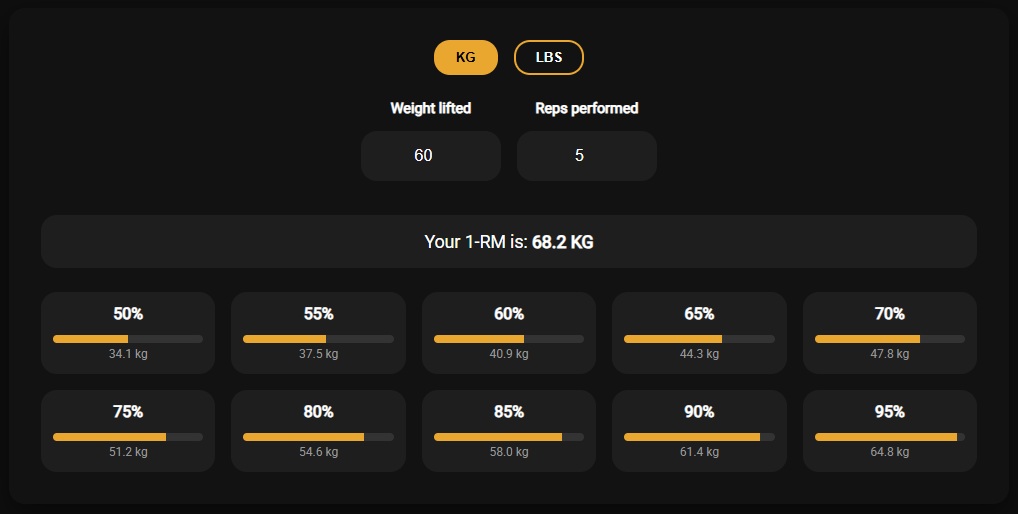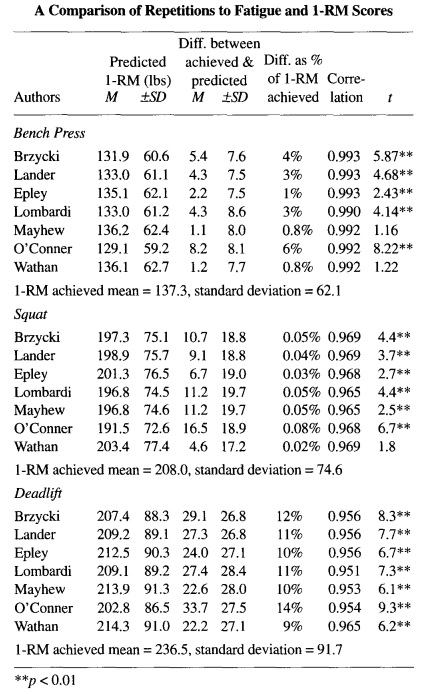How to Calculate Your One‑Rep Max (1RM)

Determining your 1 rep max (1RM) is one of the most important steps in strength training. Your 1RM represents the maximum weight you can lift for a single repetition with proper form, and knowing this number helps you set the right intensity for your workouts. Whether you’re chasing muscle growth, building strength, or improving endurance, accurately determining 1 rep max gives you a clear baseline to program your training percentages, avoid guesswork, and progress safely over time.
The Landers Formula (Used by Our Calculator)
Our 1RM Calculator is based on the Landers formula, first published in the NSCA Journal (1985).

Formula for 1rm: 1RM = (100 × Weight Lifted) / (101.3 − 2.67123 × Reps)
There are several well-known equations for estimating 1RM, such as the Epley, Brzycki, and Lombardi formulas. Each has its strengths, but we use the Landers formula because it provides a reliable balance of accuracy and safety across a wide range of rep counts. It allows you to estimate your max without attempting a risky true 1RM test, making it practical both for beginners and experienced lifters.
How to Estimate Your 1RM
- Choose a compound exercise (e.g., squat, bench press, deadlift).
- Warm up properly (e.g., 50% of your estimated working weight for 8–10 reps).
- Perform a challenging but safe set (e.g., 3–8 reps) with good form.
- Record the weight you lifted and number of reps.
- Enter those numbers into our free 1RM Calculator to get your estimated 1RM and training percentages.
What to Do with Your 1RM
- 55%–65% — endurance and form practice
- 70%–80% — hypertrophy / muscle growth
- 85%–95% — strength focus
For example, if your estimated 1RM is 100 kg, 70% is 70 kg — great for sets of 8–12 reps.
Safety Tips When Testing 1RM
- Always warm up thoroughly
- Use a spotter, especially when lifting heavy
- Reassess your 1RM every 4–8 weeks — avoid testing more often to prevent overtraining
Related Articles
- Your Guide to Calculating 1RM as a Beginner: Lift Smarter, Not Harder — step‑by‑step intro and safety advice
- Calorie Calculator — plan your nutrition to support strength goals
- Macronutrient Calculator — break down your daily calories into macros that suit your training
- AI‑Powered Personalized Workout Plan — build workouts based on your estimated 1RM and goals
FAQ
- What is a 1RM calculator and how does it work?
- It estimates your one-rep max based on the weight and reps you lifted using scientifically validated formulas like Landers, Epley, or Brzycki.
- How often should I re-test my 1RM?
- Around every 4–8 weeks is ideal — testing too often can lead to fatigue and injury.
- Is testing my real 1RM safe?
- It's safer to estimate via calculator than to attempt a true max lift. If you do test, always use a spotter.
- Can I use the 1RM calculator for bodyweight exercises?
- Yes — just enter your bodyweight as the “weight lifted” and number of reps
Ready to lift smarter? Calculate your 1RM now and take the guesswork out of your strength training.